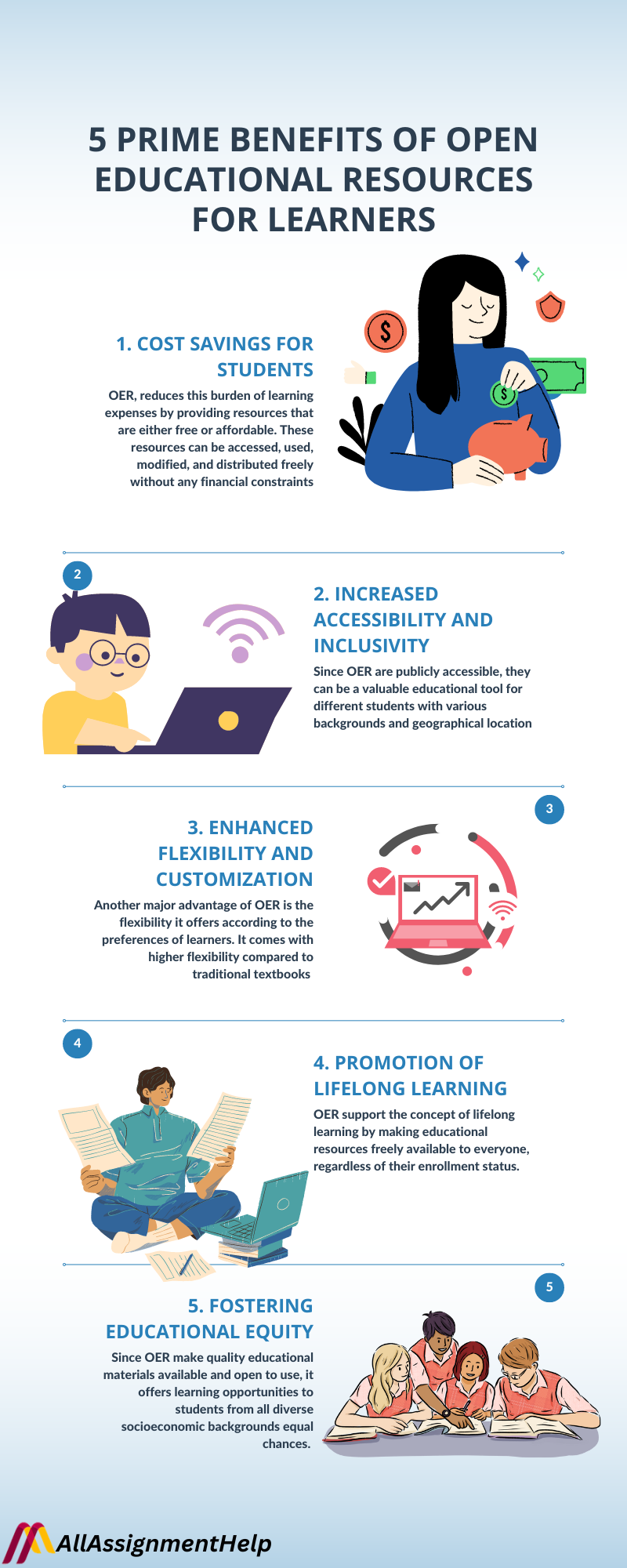Table of Contents
“OER is not just about saving money on textbooks; it’s about enhancing the quality of education by providing diverse, adaptable, and up-to-date resources.” – David Wiley
Open Educational Resources are changing the face of education by offering free learning resources available under certain copyright licenses. These resources include textbooks, curricula, lecture notes, assignments, and other forms of educational content. The adoption of OER is growing rapidly, and for good reason. Now students can learn through these resources and upskill themselves. This blog by All Assignment Help explores all the benefits of open educational resources and how students can benefit from them.
If you are interested in learning more about these educational resources and how you can leverage them for your studies, we recommend reading the complete blog post for a better understanding.
Let’s open the door to our topic.
What are Open Educational Resources?
OER or Open Educational Resources are resources utilized for learning, teaching, and research purposes available to anyone via the Internet at no cost. These can be used, modified and shared without any restrictions in various forms such as textbooks, lecture notes, assignments, tests, projects, audio, video and any other medium.
Key characteristics of OER include:
- Accessibility: This is an important characteristic of OER because anyone with an internet connection can access these resources.
- Adaptability: These resources are flexible to accommodate changes, modifications, and additions as per the users’ requirements.
- Open Licensing: OER are usually released under open licenses (CC) that enable the subsequent uses and modifications by users.
Online education resources expand the reach of education and empower students to learn and gain subjective understanding effectively. Whether you need high-quality assignment writing, thesis, or dissertation writing assistance, these free OERs have the potential to address your queries and enhance your learning experience.
Also Read: The Benefits of Online Classes for Working Professionals
Examples of OER
Textbooks: OpenStax offers free textbooks and openly licensed content for uses
Courses: MIT OpenCourseWare is a project that makes learning materials of MIT courses freely accessible to everyone.
Repositories: Some of the available websites include OER Commons, and the Open Education Consortium are known for offering various learning resources.
OER promotes an equitable educational landscape that means everyone has the right to learn and such initiatives are quite helpful for students who want to add new skills beyond their regular classroom learning. Also, these open-source learning opportunities work as a remedy for students who may find themselves asking, Can I pay someone to take my online classes for me? Whenever they are unable to deal with their online learning programmes or perform well. Instead of resorting to this, OER helps students overcome academic challenges, gain a deeper understanding of their subjects, and address any questions that were not resolved during classroom sessions.
5 Prime Benefits of Open Educational Resources for Learners

Below is a complete explanation of the benefits that students may avail themselves with online open educational resources
1. Cost Savings for Students
The most notable advantage of adopting OER is the reduced cost of learning for students. Online published learning resources such as textbooks and other educational materials by universities may be fairly expensive. According to the College Board, the average undergraduate student spends over $1,200 every year on textbooks and supplies. This financial burden can limit a student’s ability to acquire necessary materials and affect his/her performance in school.
OER, reduces this burden of learning expenses by providing resources that are either free or affordable. These resources can be accessed, used, modified, and distributed freely without any financial constraints. This not only saves the students money but also provides them with all the necessary learning resources that are must for their educational journey.
2. Increased Accessibility and Inclusivity
Since OER are publicly accessible, they can be a valuable educational tool for different students with various backgrounds and geographical locations. Regardless of whether a student is in a rural area where access to physical books is limited by various constraints or in a city with a well-stocked library, OERs are found online and can be accessed by anyone with the internet.
Students seeking online free samples or learning material may refer to assignment help online and access free educational resources for their subjective queries
3. Enhanced Flexibility and Customization
Another major advantage of OER is the flexibility it offers according to the preferences of learners. It comes with higher flexibility compared to traditional textbooks and other sources of information that cannot be easily customized to fit the needs of a particular class.
For instance, commercial textbooks don’t support modifications and can only be used in their original form, OER, however, can be revised, rearranged and customized to fit the curriculum and the students.
Teachers can modify OER, depending on the most recent information add local or cultural aspects and increase or decrease the level of difficulty for their learners. This flexibility not only increase the relevancy and engagement of the learning material but also widens the range and creativity of dynamic teaching methods.
4. Promotion of Lifelong Learning
OER support the concept of lifelong learning by making educational resources freely available to everyone, regardless of their enrollment status. This democratization of education empowers individuals to pursue knowledge and skills development at their own pace and according to their own interests.
For professionals seeking to update their skills, retirees exploring new interests, or anyone looking to learn something new, OER provide a wealth of high-quality, accessible learning materials. This promotes a culture of continuous learning and personal growth, which is essential in today’s rapidly changing world.
5. Fostering Educational Equity
Education equality is one of the most important objectives of online educational resources. Since OER make quality educational materials available and open to use, it offers learning opportunities to students from all diverse socioeconomic backgrounds equal chances. These resources are highly valuable for unfunded schools and communities where learning materials are limited.
Also, OER can help bridge the gap between resource-rich and resource-poor institutions by enabling students to access high-quality learning material at lower prices or free of cost.
Also Read: Importance of Creating an Effective Learning Space for Digital Learners
Conclusion
Open Educational Resources are revolutionising education by making learning more accessible, affordable, and flexible. The term OER has several advantages for students such as reduced education cost, remote accessibility, scope for creativity and lifelong learning opportunities. As more educators and institutions adapt these resources, the positive impact on education will continue to grow, creating a more inclusive, equitable, and dynamic learning environment for all.
Frequently Asked Questions
What is meant by Open Educational Resources (OER)?
OER is defined as materials that are used to support teaching, learning and research, which are available for anyone to use, modify and share. They are textbooks, readings, simulations, games, quizzes, etc., which are often released under Creative Commons licenses.
In what ways OER can help students and educators?
OER reduces costs for students and increases the access to education. Teachers can modify the content to suit their requirements, increase resource dissemination, and facilitate cooperative education.
How can I get OER for my courses?
OER can be found on platforms like OER Commons, OpenStax, MERLOT, and MIT OpenCourseWare.
What can I do to support OER?
By publishing your educational resources under an open license, modifying your existing OER, promoting the use of OER, and participating in OER activities and programs.
